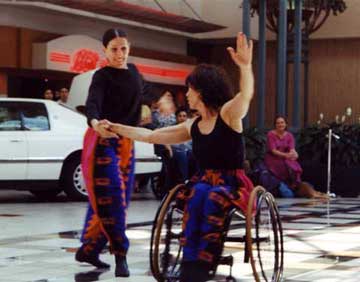Spinal Cord Injury Update
Fall 1997
Dancing on Wheels
There's a saying among old hoofers that goes, "if you can walk, you can dance." Watching Seattle wheelchair dancer and choreographer Charlene Curtiss execute dazzling twirls, rhythmic tilts, and graceful arabesques across the dance floor, a new version comes to mind: "if you have wheels, you can dance."
Curtiss, who has T12 paraplegia, is one of a handful of dancers around the world who are doing pioneering creative work in the field of wheelchair dance, an art form that is gaining popular and critical acclaim both inside and outside the disabled community. Although she is at the forefront of this burgeoning dance form, she has been dancing professionally for less than a decade, and arrived at her professional dance career via an unconventional route.
Curtiss sustained her spinal cord injury at the age of 17 in a gymnastics accident when a defective parallel bar broke. She came out of her rehabilitation program walking on crutches and short leg braces, and was convinced that if she kept working out with physical therapy she'd recover fully. "When it became apparent after a while that wasn't going to happen, I felt a little lost," she remembers.
"I went through a time when I felt real sad that I was going to live life as a disabled person," she admits, "but it passed because it had to. You get on with your life."
Curtiss continued to be involved in sports, first as a competitive swimmer in college. She was using crutches to get around, but noticed that people in wheelchairs "were all zooming by me. So I bought a wheelchair and started training in track and field." She competed in national wheelchair games for many years.
During her last year in college, her personal injury lawsuit went to trial. By the time it was settled a few years later, Curtiss had become interested enough in the field of law to attend law school at Gonzaga University in Spokane, Washington. Afterward, she came to the Seattle area to practice as a public defender.
She had never taken a dance class, but enjoyed dancing. In the privacy of her living room, she started to develop the front-end chair control technique that has become her trademark, doing wheelies and spins in time to music on her stereo. "I had to keep it tight or I'd hit the furniture," she said. After "dancing a hole in the carpet," she choreographed slalom courses to music and performed these for two years at Mariners' games.
She formed the Light Motion Dance Company, and worked a trade with wheelchair manufacturer, Kuschall of America, Inc.: a videotape of her dancing in a Kuschall lightweight chair in exchange for the chair itself.
Realizing that her desire to explore dance was starting to conflict with the demands of her profession, Curtiss took a leave of absence and spent six months working in Berkeley with another wheelchair dancer. When that was over, she knew that law would have to take second place. Since her return to Seattle in 1990, Light Motion has added non-disabled dancer Joanne Petroff, and has performed all over the country and the world, including Russia, Australia, Portugal, Ireland, and the 1996 Paralympics in Atlanta. Light Motion also gives workshops for school children and adults. When her travel schedule permits, Curtiss teaches wheelchair aerobics and front-end chair control techniques to inpatients and outpatients at the University of Washington Medical Center. She is also a member of the Northwest Regional SCI System's Consumer Advisory Board.
Curtiss has kept her law license current, but hasn't practiced since 1991. She admits to few regrets, and says she finds her new profession "amazingly fulfilling," especially since "the field of dance among disabled populations is relatively new. Light Motion is doing ground-breaking, pioneering work."
She is always eager to draw new people into the experience of dance, and insists that dance is "not about what your disability is but what your mindset is. Everyone can dance. If we look inside ourselves, each of us has a dance, and each dance is different."






